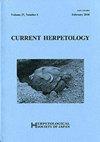Larval Prey Preference of Pond-breeding salamander Hynobius tokyoensis Living in a Stream
IF 0.7
4区 生物学
Q4 ZOOLOGY
引用次数: 3
Abstract
Habitats for pond-breeding salamanders are declining as a result of land development and management abandonment. In that context, a pond-breeding salamander Hynobius tokyoensis has recently been known to breed in small streams. However, little is known about the ecology of pond-breeding salamander larvae, such as food, in small streams. Here, to gain insight into foraging ecology of Hynobius tokyoensis larvae in small steams, we investigated the potential prey items in nine small streams running through secondary forests in Hachiouji City, Tokyo, Japan. In addition, we hypothesized that H. tokyoensis larvae preferentially predate active prey invertebrates over less-active prey because they are generalist, sit-and-wait predators. To test this hypothesis, we experimentally examined predation frequencies by H. tokyoensis larvae on the two major arthropod species (isopods and Plecoptera larvae) and activity (i.e., movement frequencies and distances) of the potential prey. As a result, isopods (Asellus hilgendorfii) and Plecoptera (Nemouridae larvae) are the two dominant aquatic invertebrates in small streams inhabited by H. tokyoensis, larval salamanders consumed more isopods than Plecoptera larvae and isopods are more active than Plecoptera larvae. Taken together, we concluded that isopods should be the main prey for salamander larvae inhabiting small streams due to their high abundance and conspicuous activities.生活在溪流中的东京蝾螈的幼虫捕食偏好
由于土地开发和管理的放弃,池塘繁殖蝾螈的栖息地正在减少。在这种情况下,一种池塘繁殖的蝾螈Hynobius tokyoensis最近被发现在小溪中繁殖。然而,人们对池塘繁殖的蝾螈幼虫的生态学知之甚少,比如小溪流中的食物。为了进一步了解东京小水蚤幼虫在小溪流中的觅食生态,我们对日本东京八尺路市次生林中9条小溪流的潜在猎物进行了调查。此外,我们假设东京纹夜蛾幼虫优先捕食活跃的无脊椎动物而不是不活跃的猎物,因为它们是多面手,坐等捕食者。为了验证这一假设,我们通过实验研究了东京纹夜蛾幼虫对两种主要节肢动物(等足类和翼翅目)的捕食频率和潜在猎物的活动(即移动频率和距离)。结果表明,等足类(Asellus hilgendorfii)和翼翅目(Nemouridae幼虫)是东京火蜥蜴栖息的小溪流中占优势的两种水生无脊椎动物,幼虫对等足类的消耗多于翼翅目幼虫,等足类的活性高于翼翅目幼虫。综上所述,等足类动物数量多,活动明显,是小溪流中蝾螈幼虫的主要捕食对象。
本文章由计算机程序翻译,如有差异,请以英文原文为准。
求助全文
约1分钟内获得全文
求助全文
来源期刊

Current Herpetology
Agricultural and Biological Sciences-Animal Science and Zoology
CiteScore
1.20
自引率
14.30%
发文量
20
期刊介绍:
Current Herpetology publishes original research articles on amphibians and reptiles. It is the official journal of the Herpetological Society of Japan and is a continuation of Acta Herpetologica Japonica (1964–1971) and Japanese Journal of Herpetology (1972-1999).
 求助内容:
求助内容: 应助结果提醒方式:
应助结果提醒方式:


